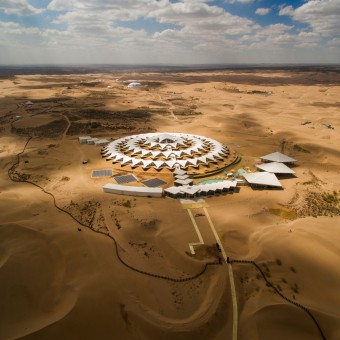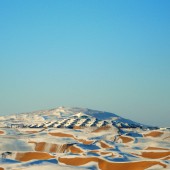Xiangshawan Desert Lotus Hotel by PLAT ASIA |
Home > Winners > #59603 |
 |
|
||||
| DESIGN DETAILS | |||||
| DESIGN NAME: Xiangshawan Desert Lotus PRIMARY FUNCTION: Hotel INSPIRATION: With the unprecedented urban expansion, desert-the most neglected portion of terrain in China, would probably bear the future opportunity of urban development. By designing the hotel, we aim for not only an oasis that would be enjoyed by the current generation, but also the use of desert for urban expansion for generations to come. Also, the form of lotus is a logical result from the purpose of sand stabilization, sun-shading, wind-load bearing and rainwater collection. UNIQUE PROPERTIES / PROJECT DESCRIPTION: Lotus Resort is part of the Xiangshawan Desert development, which would reside in Kubuqi Area. The form of lotus is not merely an artificial maneuvering of forms based on aesthetic value, but a logical result from the purpose of sand stabilization, sun-shading, wind-load bearing and rainwater collection. Moreover, as our core concept, the traditional Chinese philosophy of ‘Zhen’ has been celebrated in the design, which means replica of the identical. The logic of the form comes from simple rotations of squares, which would result in a delicate series of triangles that accentuate the visual appearance. OPERATION / FLOW / INTERACTION: Due to the resort’s special location, it was extremely hard to use cast-in-site concrete. Thus pre-cast panels were used for the design, reducing the need for skilled on-site workers. Also, passive design strategies were used in place of high-tech such as solar panels, which not only curtailed the initial investment, but also future maintenance. This has been proofed viable for the clientele. Additionally, the form of lotus has been deeply rooted in Chinese culture, which would bring the tourists a scent of nostalgia even in the barren desert and improves the experience. PROJECT DURATION AND LOCATION: Xiangshawan Desert Resort was finished in May 2016 in Inner Mongolia, China and has been open to public afterwards. It has been honored as the best of the best for Iconic Awards 2017 while being nominated for a number of prestigious awards since its opening. FITS BEST INTO CATEGORY: Architecture, Building and Structure Design |
PRODUCTION / REALIZATION TECHNOLOGY: In order to make the design buildable in desert, we invented a structural system that would be fixed in fluid sands by steel panels, which would function as a boat floating in the desert that carries the super-structure, while the sub-structure would be in relevant equilibrium due to the constant forces exerted by sands. Also, due to the lack of finish material in the area, a unique one was invented from sands, making it possible for the local to reproduce it when necessary. SPECIFICATIONS / TECHNICAL PROPERTIES: Lotus Resort is part of the Xiangshawan Desert development, which resides in Kubuqi Area. With a total area of 30700㎡, the hotel would not create as much carbon footprint as imagined. Instead of utilizing high-tech equipment such photovoltaic panels and solar batteries, we seek the most primitive methods of reducing carbon emission. For instance, the membrane is not only an eye-catching element, but also a passive design strategy to reduce solar gain for the interior, which has considerably reduced the carbon-footprints and electricity costs incurred by mechanical cooling systems. By using similar strategies, the building would become less vulnerable compared to buildings that are equipped with too much high-tech. TAGS: Hotel, Desert Resort, Future architecture, Passive design, Vernacular architecture RESEARCH ABSTRACT: By research, China’s urban population will increase by three to seven millions by 2050. However, research also shows that the unprecedented urban expansion would negatively affects the agriculture land use, eventually reducing the food production capacity. Both of them would create heavy burdens on China’s natural land resources, and the solutions for both seem to be a dead end. Ionically, desertification rate in China has reached a striking statistic of 0.0018 square kilometers per second, which means the portion of desert would soon outreach 13 percent of the total land area. With the statistic and trend analysis in the research, it was suggested that desert areas could bear the possibility of urban expansion in near future. CHALLENGE: Due to the drastic lack of finish materials and skilled workers in the area, it would have been very likely that we had to transport materials and manpower from nearby cities, which would incur large amounts of extra costs and carbon footprints. Therefore, after series of trials, we successfully invented a new kind of finish material from sands, which pervade in the local context. This not only reduced the capital investment in the project, but future maintenance cost as well, since it would be possible for the local to reproduce the finish material. ADDED DATE: 2017-08-24 10:20:07 TEAM MEMBERS (5) : Donghyun Jung, Bian Baoyang, Satoshi Maeda, Qiao Wenke and Dao Huiling IMAGE CREDITS: Image #1:Xiangshawan Resort,2016 Image #2:Xiangshawan Resort,2016 Image #3:Xiangshawan Resort,2016 Image #4:Xiangshawan Resort,2016 Image #5:Xiangshawan Resort,2016 |
||||
| Visit the following page to learn more: http://www.plat.asia/project/19/5 | |||||
| AWARD DETAILS | |
 |
Xiangshawan Desert Lotus Hotel by Plat Asia is Winner in Architecture, Building and Structure Design Category, 2017 - 2018.· Press Members: Login or Register to request an exclusive interview with PLAT ASIA. · Click here to register inorder to view the profile and other works by PLAT ASIA. |
| SOCIAL |
| + Add to Likes / Favorites | Send to My Email | Comment | Testimonials | View Press-Release | Press Kit |







